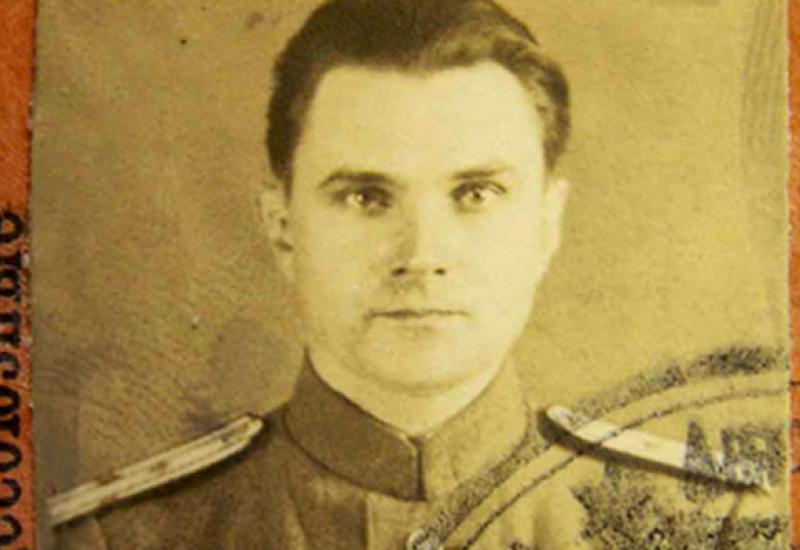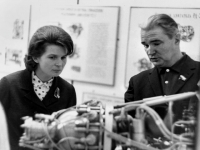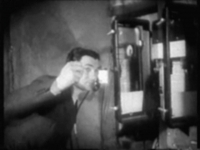Valentin P. Glushko was born in Odessa, September 2, 1908. In the 1919-1924 he studied at a vocational technical school. At the same time in 1920-1922 he studied at the Conservatoire to play a violin. Spring of 1921, Valentin, having read the books of Jules Verne "From guns to the Moon" and "Around the Moon", decided to devote his life to the implementation of such operations. He started from astronomical observations, was the head of the group of young researchers in the world. Winter 1922 he found in the Odessa public library the Tsiolkovsky book and began to study his works. In the autumn of 1923 he wrote Tsiolkovsky letter and received a written response with several works Tsiolkovsky. Thus began their correspondence that lasted several years. In 1924 the young Valentin Glushko wrote the book "The issue of exploitation of the planets," which was not published, and subsequently published in newspapers and magazines several popular science articles devoted to space flight, in particular, "The conquest of the Moon by the Earth" (1924), "The station outside the Earth "(1926.).
Having graduated high school, V.P. Glushko in 1925 went to study at the Leningrad State University, but did not pass the admission exam and the first year he was studying as a free listener. In 1926 he was admitted to the second year of the Physical Department of Physics and Mathematics Faculty of Leningrad State University. At the same time he worked as a worker, and then - a surveyor.
The theme of the diploma V.P. Glushko was the project of the spaceship "Gelioraketoplan" with electric propulsion vehicles (EPV). In April 1929 the part of this work, dedicated to electric propulsion, Glushko passed to the Committee for Inventions. The military had the interest in these ideas , and in May 1929, after graduating from LSU, V.P.Glushko began working in the Gas Dynamics Laboratory (GDL). He made prototypes of electric propulsion, proved their efficiency, and ... began to develop liquid rocket engines (LRE). For low-power electric propulsion can be used in spacecraft already in orbit. For the first time, these engines were used in 1964, for the orientation of the spacecraft "Voskhod" and reboost the station "Zond 2".
In GDL Glushko created the first domestic engine LRE ORM-1 with a thrust 20 kg of force and then a number of other engine series ORM, which it was used a pair of nitric acid - kerosene. He experimented with other substances.
Since 1934 V.P.Glushko began working in Moscow in Rocket Research Institute, created by combining the GDL and Moscow's Jet Propulsion Research Group. Here, in particular, he developed liquid fuel rocket engine ORM-65 for the rocket plane RP-318 and cruise missile 212 of S.P.Korolev design.
In 1938 the leaders of RRI were arrested then Glushko and Korolev were arrested too. A year later, V.P. Glushko became the chief designer of OKB-16 closed the NKVD (the so-called "sharaga"), where he developed rocket boosters for aircraft. In July 1944, 35 prisoners from the OKB-16 (including - VP Glushko and SP Korolev) were released, and were given the task to create a military rockets.
In 1945 Glushko and Korolev, in the group of Soviet specialists studied in Germany the German V-2 rocket and equipment for their production. Reconstituted by EDB of Korolev rocket flew up October 18, 1947 from Kapustin Yar. And next year a ballistic missile R-1 of Korolev with Glushko engine RD-100 was launched.
Then there were the RD-101 (for P-2) and RD-103M (for R-5 and R-5M). In 1957 began the test of RD-107 and RD-108 and R-7 rocket, which became the basis of many space launch vehicles. Constantly improving, they are still firmly in orbit spacecraft. To combat missiles, which had to be launched in a very short time, DB V.P. Glushko in 1957 developed the engine, where there were used the components with high boiling point.
In October 1953 VP Glushko was elected a corresponding member of the Academy of Sciences of the USSR. October 26, 1957 decision of the Higher Attestation Commission of the USSR he was awarded the degree of Doctor of Technical Sciences without defending a thesis. In 1958 he was elected a full member of the Academy of Sciences of the USSR. V.P. Glushko headed the Scientific Council on the issue of "Liquid fuel" of the Presidium of the USSR Academy of Sciences, was the chief editor of the Encyclopedia "Space", managing editor of the reference book "Thermodynamic and transport properties of combustion products", lectured at the Moscow Higher Technical School. V.P. Glushko was twice awarded the title of Hero of Socialist Labor, was awarded five Orders of Lenin, Order of October Revolution, Red Banner of Labor and many medals.
May 22, 1974 V.P. Glushko was appointed director and general designer of SPA "Energia" (uniting EDB S.P. Korolev, V.P. Glushko bureau and some other enterprises). Under his leadership it was being developed orbital station "Mir", improved "Soyuz" space station "Salyut". The top point in V.P. Glushko as the engineer creativity was the creation of the carrier rocket "Energy" with the most powerful in the world rocket engine RD-170 and the space shuttle "Buran".
VPGlushko did not leave work until the last days of his life and died on January 10, 1989 - two months after the successful flight "Buran". The name of Valentin Glushko was given to a minor planet number 6357 and a crater on the Moon. Russian Cosmonautics Federation introduced the Gold Medal V.P. Glushko.




